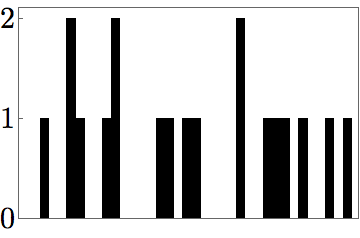Two states or three?
 You have a radio that can measure incoming signals from deep space. You measure a signal that appears to be a stream of pulses with relative amplitudes 0, 1, or 2. You measure the signal for a long time and determine that you receive 2s only 15% of the time (i.e.
f
(
2
)
=
0
.
1
5
). You claim this shows there is some structure to the signals and perhaps you're receiving messages from a distant civilization.
You have a radio that can measure incoming signals from deep space. You measure a signal that appears to be a stream of pulses with relative amplitudes 0, 1, or 2. You measure the signal for a long time and determine that you receive 2s only 15% of the time (i.e.
f
(
2
)
=
0
.
1
5
). You claim this shows there is some structure to the signals and perhaps you're receiving messages from a distant civilization.
Your partner is more skeptical and insists that what you're measuring is actually the superposition of signals from two identical spinning neutron stars . For simplicity, each neutron star can emit a short burst of radio waves of fixed intensity 1. If both neutron stars emit at the same time, you'll measure a signal of intensity 2.
To prove that this can't be the case, you measure the fraction of 0s, f ( 0 ) in the signal and proudly announce that the signal can't possibly be the superposition of noisy neutron stars. What is the greatest possible value you measured for f ( 0 ) ?

Assumptions and Details
- You can measure the stream for as long as you like, i.e. you can determine f ( 0 ) , f ( 1 ) , and f ( 2 ) to arbitrary accuracy.
- Each pulse lasts for τ seconds, and the time between pulses is some integer (possibly 0) multiple of τ .
The answer is 0.375403.
This section requires Javascript.
You are seeing this because something didn't load right. We suggest you, (a) try
refreshing the page, (b) enabling javascript if it is disabled on your browser and,
finally, (c)
loading the
non-javascript version of this page
. We're sorry about the hassle.
3 solutions
Your solution is intersting, but has a little flaw according to me when it comes to the interpretation of the measure of f(0).
You showed that, if the two stars have the same probability of emission, then f(0) = 0.3754.
Unfortunately, it tells you nothing of the case where these probabilities are different, and it is no real help to interpret the result of the measure of f(0):
• If f(0) > 0.3754, what can you deduce ?
• If f(0) = 0.3754, you have a good indication that the two probabilities are equal (although you did not demonstrate that)
• If f(0) > 0.3754, what can you deduce ?
This interpretation can only be done if you allow these probabilities to be different and study how f(0) varies with these.
Log in to reply
Hi @mat baluch , that the two stars are equal was actually an unstated assumption of the problem. I've changed the wording to make that explicit now.
Log in to reply
Hi Josh Silverman , if the two stars are equal this also should change the way the question is stated.
In this case, f(0) = 0.375 when the signal is a superposition (it cannot take values between 0 and 0.375, as in the case where the stars can have different pulsations), and the question would rather be: "What is the value you could not have measured for f(0) ?"
I would not make this assumption in the problem, it is more interesting without it.
There seems to be a mistake in the exercise description.
If the signal is the superposition of two noisy (not correlated) signals of stars, with f(2) = 0.15, then f(0) can vary from 0 up to a maximum of 0.3754... (see other solutions for details)
Measuring a value for f(0) that is greater than 0.3754 proves that the signal cannot be the superposition of two noisy signals.
This should then be reformulated: "What is the smallest possible value you measured for f(0)"
I don't think so. Like you say, f ( 0 ) can range from 0 up to the limit near 0 . 3 7 5 , so the maximum value it can take in a superposition is the upper limit.
Log in to reply
I agree with Mat Baluch.
Even if the probabilities of emitting a pulse are distinct say p and q then we have:
p q = 0 . 1 5
( 1 − p ) ( 1 − q ) = P ( 0 ) = k (say)
( 1 − p ) q + ( 1 − q ) p = p + q − 2 p q = p + q − 0 . 3 = P ( 1 ) = 0 . 8 5 − k
p + q = 1 . 1 5 − k
Also, by AM-GM we have p + q ≥ 2 p q = 2 0 . 1 5
Thus, k ≤ 1 . 1 5 − 2 0 . 1 5 = 0 . 3 7 5
Hence we get an upper bound for k . To show that all of the above is not possible , we need to give an instance where k exceeds this upper bound. So, we have a smallest value of k that contradicts our hypothesis.
I request @Josh Silverman to respond to this. Once again a nice problem by @Josh Silverman .
Yes, 0.375 is the maximum value f(0) can take in case of a superpsition of noisy signals.
But this is not the question: as you wrote: "[you] measure the fraction of 0s, f(0) in the signal and proudly announce that the signal can't possibly be the superposition of noisy neutron stars".
So the question is: how can you be certain that the signal is not a superposition ?
To be sure that the signal is not a superposition, you need to have measured a value outside [0; 0.375] for f(0). Hence a value greater than 0.375, which is the smallest possible value you measured for f(0).
Let p and q be the probabilities of a burst from each star at any time "slot". Then p q = 0 . 1 5 , and we find the maximum value ( 1 − p ) ( 1 − q ) can have, which works out to 0 . 3 7 5 4 0 3 . . .
Let's assume that both the neutron stars emit a short burst of radio waves with probability p independently.
Using Rule of Product , probability of measuring signal of intensity 2 is p 2 = f ( 2 ) = 0 . 1 5 . Hence p = 0 . 1 5 .
Using Probabilistic Principle of Inclusion and Exclusion , the probability of measuring a signal of at least intensity 1 is f ( 1 ) + f ( 2 ) = p + p − p 2 = 0 . 1 5 + 0 . 1 5 − 0 . 1 5 ≈ 0 . 6 2 4 6 .
Since measuring signals of intensity 0, 1, and 2 are mutually exclusive and collectively exhaustive events, their sum is equal to 1 . f ( 0 ) + f ( 1 ) + f ( 2 ) = 1 , we get f ( 0 ) = 1 − ( 2 0 . 1 5 − 0 . 1 5 ) ≈ 0 . 3 7 5 4 □